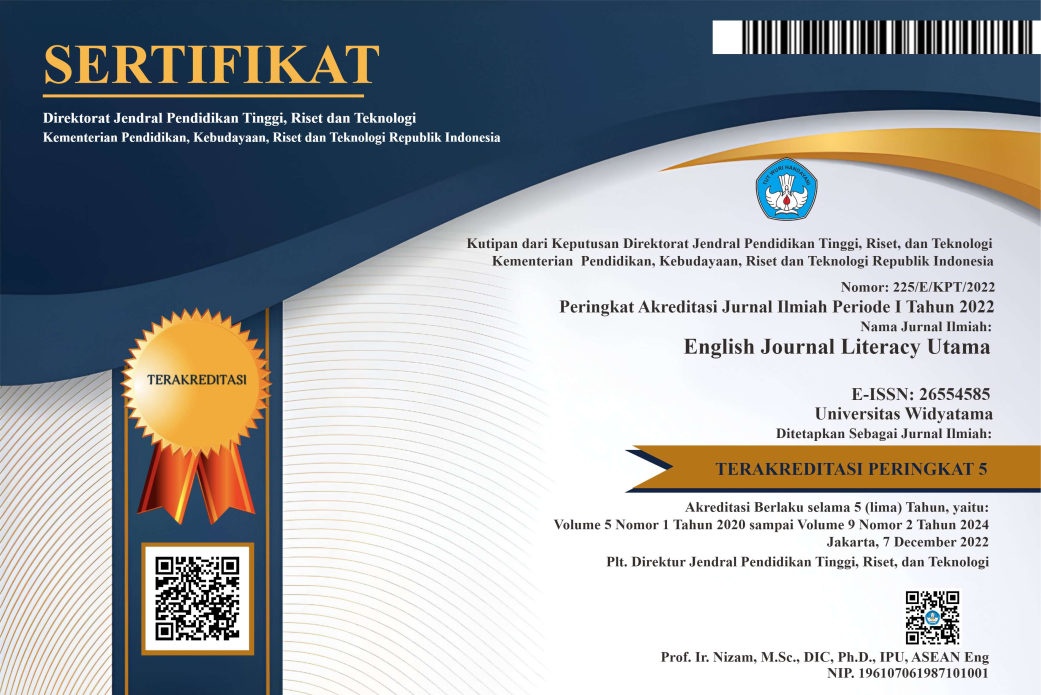THEMATIC PROGRESSION ON A NEWS TEXT ENTITLED “HEALTH MINISTRY ENSURES NO DATA LEAK IN PEDULILINDUNGI APP” FROM THE JAKARTA POST
DOI:
https://doi.org/10.33197/ejlutama.v7i2.172Keywords:
Thematic progression, theme and rheme, news textAbstract
This study aims to find out which theme is mostly used in the news text entitled “Health Ministry Ensures No Data Leak in PeduliLindungi App” and identify the kinds of patterns of thematic progression used in the news text. The method used for this study is descriptive qualitative. This study uses Paltridge (2012) thematic progression and Halliday (1985) theme and rheme as grounded theory. The result of the study showed that the most used theme from the news text is textual theme and the pattern of thematic progression used for this news text is multiple themes or split rheme. The result for the kind of theme used by the news text is considered from the number of times textual theme used in the news text which is about 23 times or 57.5%. The pattern of thematic progression used by the news text is multiple theme or split rheme because there are a mix of constant theme and linear theme on the overall pattern of the news text. Based on the pattern of thematic progression the number of constant themes used in the news text is 10 times and linear theme is three times, which makes it considered as a multiple theme or split rheme.
References
Bloor, M. (2004). The functional analysis of English. New York: Oxford University Press.
Bogdan, R., & Biklen, S. K. (1982). Qualitative research for education: An introduction to theory and methods. Allyn & Bacon, Inc.: Boston London.
Celce-Murcia, M., & Olshtain, E. (2000). Discourse and context in language teaching: A guide for language teachers. Cambridge University Press.
Chang, P., & Lee, M. (2019). Exploring Textual and Interpersonal Themes in The Expository Essays of College Students of Different Linguistic Backgrounds. English for Specific Purposes, 54, 75-90. https://doi.org/10.1016/j.esp.2019.01.002
Cornbleet, S., & Carter, R. (2001). The language of speech and writing. London: Routledge.
Eggins, S. (2004). Introduction to Systemic Functional Linguistics (2nd ed.). A&C Black.
Fatmawati, D. (2019). Thesis. Thematic Progression Analysis In The Black Cat Short Story.
Gerot, L., & Wignell, P. (1995). Making sense of functional grammar: An introductory workbook. Cammeray: Gerd Stabler.
Halliday, M. A. (1985). An introduction to functional grammar. London: Edward Arnold.
Halliday, M., & Matthiessen, C. M. (2004). Halliday's introduction to functional grammar (3rd ed.). London: Edward Arnold.
Halliday, M., Matthiessen, C. M., Halliday, M., & Matthiessen, C. (2014). An introduction to functional grammar. Routledge.
Jing, W. (2015). Journal of Education and Practice. Theme and Thematic Progression in English Writing Teaching, 6.
Knapp, P., & Watkins, M. (2005). Genre, text, grammar: Technologies for teaching and assessing writing. Sydney: University of New South Wales Press.
Loeb, S., Dynarski, S., McFarland, D., Morris, P., Reardon, S., & Reber, S. (2017). Descriptive analysis in education: A guide for researchers. NCEE 2017-4023. Washington, DC: U.S. Department of Education, Institute of Education Sciences, National Center for Education Evaluation and Re gional Assistance.
Paltridge, B. (2012). Discourse analysis: An introduction (2nd ed.). Bloomsbury Publishing.
Wanodyatama, N.P. (2019) Relational Process in The Newspaper of The Jakarta Post Edition of February 2015-June 2015: A Functional Grammar Approach. Lingua Didaktika: Jurnal Bahasa dan Pembelajaran Bahasa, 13(1), 1-10
Downloads
Published
Issue
Section
License
Copyright (c) 2023 Thania Fitriani, R.Vindy M.Puspa, Nike Puspita Wanodyatama Pasaribu, Leila Shanty

This work is licensed under a Creative Commons Attribution-NonCommercial-ShareAlike 4.0 International License.
Creative Commons Attribution-ShareAlike 4.0 International License















